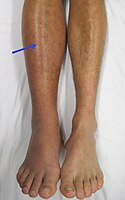
Photo from wikipedia
Blood clots play a diametric role in our bodies as they are both vital as a wound sealant, as well as the source for many devastating diseases. In blood clots'… Click to show full abstract
Blood clots play a diametric role in our bodies as they are both vital as a wound sealant, as well as the source for many devastating diseases. In blood clots' physiological and pathological roles, their mechanics play a critical part. These mechanics are non-trivial owing to blood clots' complex nonlinear, viscoelastic behavior. Casting this behavior into mathematical form is a fundamental step toward a better basic scientific understanding of blood clots, as well as toward diagnostic and prognostic computational models. Here, we identify a hyper-viscoelastic damage model that we fit to original data on the nonlinear, viscoelastic behavior of blood clots. Our model combines the classic Ogden hyperelastic constitutive law, a finite viscoelastic model for large deformations, and a non-local, gradient-enhanced damage formulation. By fitting our model to cyclic tensile test data and extension-to-failure data, we inform the model's nine unknown material parameters. We demonstrate the predictability of our model by validating it against unseen cyclic tensile test and stress-relaxation data. Our original data, model formulation, and the identified constitutive parameters of this model are openly available for others to use, which will aid in developing accurate, quantitative simulations of blood clot mechanics.
Journal Title: Biomechanics and modeling in mechanobiology
Year Published: 2021
Link to full text (if available)
Share on Social Media: Sign Up to like & get
recommendations!